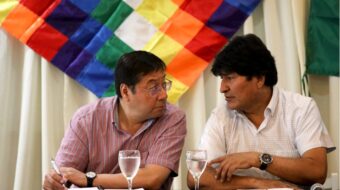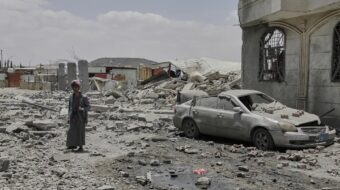
The School of the Americas (SOA) is a combat training school for Latin American soldiers, located in Fort Benning, Ga. It has trained over 64,000 Latin American soldiers since 1946. After the Pentagon was forced to acknowledge the use of torture manuals discovered at the school, it was closed down, but almost immediately reopened under a new name: Western Hemisphere Institute for Security Cooperation. The SOA has been popularly dubbed “the School of Assassins.”
After learning that graduates of the School of the Americas were responsible for the rape and murder of his fellow Maryknoll Missioners in El Salvador, Maryknoll priest Father Roy Bourgeois began to investigate and protest the existence of the school with a small group of activists called School of the Americas Watch. Since 1990, this movement has grown to tens of thousands, and last year 19,000 people from around the country held a vigil at the gates of Fort Benning calling for its closing.
A nonviolent grassroots movement that seeks to stand in solidarity with the people of Latin America, SOA Watch has had over 200 of its members spend time in jail for acts of civil disobedience.
In 2004, Father Bourgeois met with Venezuela’s President Hugo Chávez to request that Venezuela consider withdrawing its troops from the SOA, where 4,000 Venezuelan soldiers had trained. Chávez agreed to this request, and Venezuelan troops were immediately withdrawn. This successful encounter led to the “Latin America initiative” of SOA Watch, which requests the withdrawal of troops from SOA.
In March, a delegation of SOAW activists traveled to Argentina, Uruguay and Bolivia where they were able to affirm the immediate withdrawal of Argentine and Uruguayan troops and the gradual withdrawal of Bolivian troops.
In August and September, SOAW sent another delegation to Ecuador, Peru and Chile. Human rights activist Lisa Sullivan was a member of this delegation.
Many years ago, I stood in a cemetery in Santiago, Chile, as the fall leaves swirled in the wind. I had traveled — thousands of miles — to this immense burial ground, where I furtively made my way to the back lot. Oddly, it was the most beautiful spot I had found in this city.
Acquaintances had whispered to me where I would find what I was looking for. I scanned the large gray wall of niches until I spotted what I sought, and slowly approached and read: Victor Jara, 1932-1973. I looked over my shoulder before scrawling something next to hundreds of other words, some of them whitewashed over. This was 1980. The dictatorship of Gen. Augusto Pinochet stood firmly, and the country was ruled by fear.
As I looked up at the tomb of this gentle singer/songwriter who had been tortured and murdered in the first days following a bloody coup, one of his songs floated through my head:
Fragile as a kite, on the rooftops of Barrancas
Plays the child, Luchin, with his purple hands …
If there are children like Luchin, who eat dirt and worms
Let us open all the cages so that they may fly like birds.
My mind burned with a question: how could someone who sang with such tenderness about a child as fragile as a kite be beaten brutally until his bones broke? How could someone whose plea was that we free children from the cage of poverty have his body pumped with 36 bullets? No one is born capable of unleashing such inhumanity; where could this be learned?
Twenty-six years later, I discovered the answer to this question: at the School of the Americas. Former Chilean military officer Edwin Dimter Bianchi, now an anonymous bureaucrat working in Chile’s Pensions and Audit Department, was recently identified as Jara’s killer.
Those who were present at the stadium where Jara and thousands of others were held in the days following the coup that toppled elected President Salvador Allende identified Dimter. A graduate of the SOA course in “Combat Arms Orientation,” Dimter, along with dozens of other Chilean graduates, returned to his country to participate in a bloody rampage that exterminated over 3,000 lives in order to impose and maintain one of the longest and most repressive dictatorships of the Americas.
Though Pinochet was not an SOA graduate, many of his closest aides — including key leaders of the intelligence agency that was responsible for the vast majority of the disappearances and murders, the DINA — were SOA graduates. For many years, Pinochet’s sword adorned the wall of the commander of this institution that had taught such inhumanity.
Just recently, on an early spring morning in the Southern Hemisphere, I returned to the cemetery in Santiago along with SOAW delegates Roy Bourgeois, Linda Panetta and Carlos Mauricio.
This time there was no need to search discretely. Free maps of the cemetery highlighted Jara’s tomb, a small but significant symbol of change in the now democratic Chile. The entrance to the cemetery held a new and imposing granite stone, engraved with the names of the thousands of victims of the dictatorship. Below the names, water collected from all of Chile’s lakes and rivers flowed over stones brought from the seas where many of the bodies were thrown from planes, in a pulsating rhythm that seemed to say, “Nunca más,” “never again.”
Realizing ‘never again’
It was that hope of “never again” that had brought us to Chile. Recognizing that Chile was in a process of healing from years of military abuses, we had come to ask that the government stop sending troops to the SOA. The thinking behind this new “Latin American strategy” was simple: if there were no more students, there would be no more school.
On previous trips to Venezuela, Argentina, Uruguay and Bolivia, we received the good news from leaders that they would withdraw their troops from the SOA, some immediately and some gradually. [See “South America turning against School of the Americas,” PWW 4/15/2006.] This time our travels brought us to Ecuador, Peru and Chile.
Given the large numbers of Chilean students at the SOA, our visit to Chile was key. Only Colombia has sent more students to the school in the past decade. We had hopes of meeting with Chile’s president, Michelle Bachelet. Her own father, a general who had opposed Pinochet, was an indirect victim of the SOA, having died after mistreatment in prisons overseen by SOA graduates. But as former defense minister, Bachelet had continued to send large numbers of army officers to train at the SOA.
President Bachelet responded to our request with a letter affirming that the SOA was indeed an important issue, and that she had asked her defense minister to meet with us to discuss it.
A plea for the children
From the start of our meeting, Defense Minister Vivianne Blanlot openly acknowledged the terrible abuses unleashed by graduates of the SOA. We presented our own concerns and request that Chile withdraw its troops from this school. Chilean Pablo Ruiz asked if he could say a word “as a former political prisoner and torture victim.” This plea, he said, was not made in the name of healing abuses of the past. It was a plea in the name of his children, of all of Chile’s children, that they may never experience a repeat of this tragic history.
He reminded the minister that during the Allende government, many key military officers trained at the SOA, to later return and participate in his bloody overthrow. As long as Chile continues to train troops at this school, what guarantee is there that history will not repeat itself? After a moment of thoughtful silence, the minister stated that she would take the step of recommending to the army that they refrain from sending more officers to this school.
We were quite pleased with the results of this meeting, but many of the Chilean human rights activists were less enthusiastic. It had not been public information that Chile continues to send officers to the SOA. Only after being asked by a Chilean newspaper, as a result of our visit, did the Defense Department acknowledge that 170 officers were scheduled to attend the SOA this year. This information created a sense of outrage.
Also, the minister made it clear that while she would strongly “recommend” to the army that they stop sending officers to train at the SOA, she was not in a position to “impose” such a decision. This highlighted a growing concern that much more must be done to assure that the Chilean military be held responsible to the civilian government rather than vice versa.
Meeting with Chileans
We participated in numerous meetings, forums and media events, where we found tremendous interest in the SOA and support for withdrawal of Chilean troops. Students, teachers, ex-political prisoners, lay leaders, sisters, priests and activists were committed to educating the public about the issue and pressuring their government to withdraw. A consortium of human rights organizations placed the withdrawal of Chilean troops from the SOA as top priority for their bicentennial agenda. A dozen groups committed enthusiastically to organizing a vigil on Nov. 19, the day SOAW will be protesting at Fort Benning.
Several Chilean congressmen, including Tucapel Jimenez, whose father was a labor leader killed by an SOA graduate, decided to draft legislation to demand the withdrawal of Chilean troops from the SOA.
Ecuador and Peru
Our visits to Ecuador and Peru were similar. In all three countries we were able to meet with high-level government officials, where we received serious attention and obtained commitments to reconsider their participation in the SOA.
In Ecuador, with elections right around the corner, we decided to share our concerns with all the presidential candidates as well, and personally met with the leading candidate of the moment, León Roldós, who agreed to support withdrawal of Ecuadorian troops as part of his platform.
Thanks to ample media attention, the SOA was catapulted into the public eye and public debate took place. We shared our concerns about the SOA in dozens of forums and meetings organized by local organizations.
Perhaps what is most important of all, in each of these three countries, key organizations and individuals stepped forward to seriously commit to efforts to pressure their governments to withdraw their country’s troops from the SOA and to participate in the larger effort to close this school forever.
Not just in Fort Benning
We were also reminded by many of our counterparts in these countries that the interests represented by the SOA and the tactics taught at that school are not limited to the halls of Fort Benning. More and more there is concern that as the spotlight shines ever brighter on the SOA, the Pentagon is moving its instructors, tactics and techniques to hidden and not-so-hidden places in Latin American countries. We heard this in Bolivia during our previous trip, and in Ecuador this concern was expressed regarding the U.S. military base in Manta, Ecuador.
Next year, a continent-wide meeting will be held to strategize around opposition to this and other U.S. military bases. Local organizations strongly requested the support of the SOAW movement at the conference.
In Peru, we found even more concern about the presence of 1,031 U.S. military personnel from the Southern Command in Lambayeque, in northern Peru. Called Nuevo Horizonte and billed as a “civic humanitarian” mission, the initiative involves training Peruvian troops as well. Local newspapers carried articles about the military mission with such intriguing titles as “The Savior Who Came From the Skies,” in reference to one of the women helicopter pilots who “became an angel for the poor of Lambayeque.”
What they forgot to report was that these “angels” are bringing with them hundreds of arms and munitions as well. We received a list, straight from the website of the Peruvian Congress, of the exact guns they are bringing. When a Peruvian congresswoman took us to meet with the prime minister to share our mutual concerns about the SOA, the congresswoman addressed this issue as well, seeing it as a different chapter in the same book. She and others promised to rally support for withdrawing Peruvian troops from the SOA and asked if we would be there for them in opposing this new disguised version of the SOA on their own soil.
No shortcuts
When people ask how such a growing movement came to be, Father Bourgeois always says, “There are no shortcuts.” All of our efforts are necessary to close this school of assassins and to make sure that no new schools appear in different forms. Together, from east to west and north to south of our Americas, we must continue to join hands so that there will be no old or new schools that somehow motivate soldiers to silence the voice of a poet in the name of freedom.
Victor Jara’s voice was never silenced. We met with his widow on a rainy morning in Santiago. We cried as she showed us a video of Victor, and she cried as we showed her a video of the SOA, and asked what she could do to close this school. When I pointed out to her my delight in finding the words to “Luchin” on her wall, she said what a shame it was that many of Victor’s words such as these were still so pertinent. Such as these, which were sung by thousands on the day that the stadium where Col. Dimter broke Victor’s hands was renamed “Estadio Victor Jara”:
Listen to our song
it is fire of pure love
dove and dove’s nest,
leaves of an olive branch,
it is the universal song,
a cry which will bring to
triumph
the right to live in peace
Lisa Sullivan is a human rights activist and former Maryknoll lay missioner. She has worked in Latin America for over 20 years.









